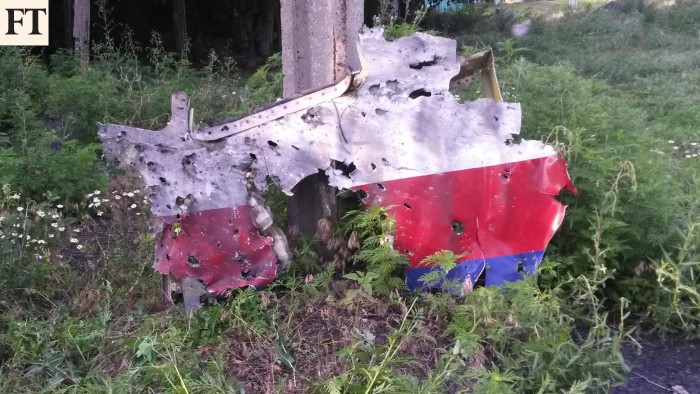MH17 crash: FT photo shows signs of damage from missile strike

Roula Khalaf, Editor of the FT, selects her favourite stories in this weekly newsletter.
The first apparent hard evidence that Malaysia Airlines Flight MH17 was brought down by a surface-to-air missile is emerging from the crash site in eastern Ukraine, after experts confirmed on Monday there were signs of shrapnel damage to the aircraft.
The photograph above, first published by the Financial Times over the weekend, shows a piece of the downed Boeing 777 about a metre square with a gaping hole in the middle, surrounded by smaller holes and apparent burn marks.
The wreckage was recovered by the people of Petropavlovka from a villager’s back yard last Thursday and moved to the roadside because it was believed to be important.
Two defence analysts in London and a former military pilot who have studied the picture corroborated the claim by a local man, who said he had served in the military, that much of the damage was consistent with a missile strike.
Over the weekend, western intelligence agencies pointed to mounting evidence that backs Ukraine’s claim that the aircraft with 298 people on board was shot down by mistake by pro-Russian separatists and Russian military personnel with an SA-11 missile launched from a Buk-M1 SAM battery.
Justin Bronk, an analyst at the Royal United Services Institute in London, said: “The size of the shrapnel holes is consistent with what one might expect to see from an SA-11 hit. However, it is difficult to assess the total blast pattern with such a small fragment of fuselage.”
Another analyst, Douglas Barrie of the International Institute for Strategic Studies, said the photographic evidence “was consistent with the kind of damage you would expect to see from the detonation of a high explosive fragmentation warhead of the type commonly used in a SAM system”.
Both analysts cautioned, however, that further work would be needed to ascertain exactly what had happened, including chemical testing for explosive residue.
In depth

News and analysis on the shooting down of Malaysia Airlines Flight MH17 by a missile over eastern Ukraine
One former senior Royal Air Force officer who was shown the picture said he had seen similar damage on aircraft that had been hit by flying shrapnel from rocket attacks on airbases.
All three experts agreed that the large hole in the middle of the fragment was likely to have been punched from the inside out as the aircraft rapidly depressurised when it was hit at a height of 33,000ft last Thursday afternoon.
All three confirmed the part of the aircraft in the photograph was the port side of the Boeing 777’s cockpit. The former RAF officer, who flew fast jets, said that based on the evidence it would appear that the missile exploded in front and to the left of the aircraft.
Anti-aircraft missiles are not designed to score a direct hit as they are targeted to destroy fast, agile fighter jets. Instead, they are designed to explode within about 20m of their target, sending out a cloud of red hot metal to increase the chances of inflicting as much damage as possible.
The former RAF pilot said an explosion in front of the aircraft would be consistent with the interception course a SAM would be expected to follow. “The last thing a ground-launched missile wants to do is play catch-up with an aircraft, it would look to get ahead of its target,” he said.
Comments